CCNA – IP Routing Questions
Here you will find answers to IP Routing Questions
Question 1
Refer to the exhibit. Assume that the routing protocol referenced in each choice below is configured with its default settings and the given routing protocol is running on all the routers. Which two conditional statements accurately state the path that will be chosen between networks 10.1.0.0 and 10.3.2.0 for the routing protocol mentioned? (Choose two)
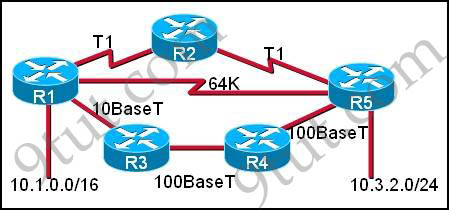
A. If OSPF is the routing protocol, the path will be from R1 to R3 to R4 to R5.
B. If OSPF is the routing protocol, the path will be from R1 to R2 to R5.
C. If OSPF is the routing protocol, the path will be from R1 to R5.
D. If RIPv2 is the routing protocol, the path will be from R1 to R3 to R4 to R5.
E. If RIPv2 is the routing protocol, the path will be from R1 to R5.
Answer: A E
Explanation
First we need to know the speed of these links:
+ T1: 1.544 Mbps
+ 10BaseT: 10 Mbps
+ 100BaseT (often referred to as FastEthernet): 100Mbps
OSPF chooses the best path via bandwidth while RIP only uses hop count (the sum of routers to reach the destination).
Therefore if OSPF is used, it will choose the path R1 -> R3 -> R4 -> R5 because these links have much higher speed than other paths -> A is correct.
But if RIP is used it only counts the number of routers to reach the destination (the less the better) so it will choose path R1 -> R5 (hop count: 1) -> E is correct.
Question 2
Refer to the exhibit. Which three statements are true about how router JAX will choose a path to the 10.1.3.0/24 network when different routing protocols are configured? (Choose three)
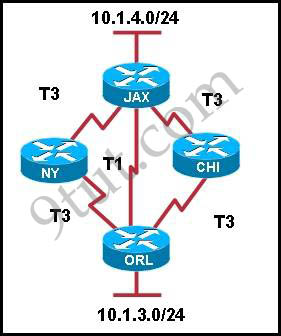
A. By default, if RIPv2 is the routing protocol, only the path JAX-ORL will be installed into the routing table.
B. The equal cost paths JAX-CHI-ORL and JAX- NY-ORL will be installed in the routing table if RIPv2 is the routing protocol.
C. When EIGRP is the routing protocol, only the path JAX-ORL will be installed in the routing table by default.
D. When EIGRP is the routing protocol, the equal cost paths JAX-CHI-ORL, and JAX-NY-ORL will be installed in the routing table by default.
E. With EIGRP and OSPF both running on the network with their default configurations, the EIGRP paths will be installed in the routing table.
F. The OSPF paths will be installed in the routing table, if EIGRP and OSPF are both running on the network with their default configurations.
Answer: A D E
Explanation
First we need to know the speed of these links:
+ T1: 1.544 Mbps
+ T3: 45 Mbps (each T3 line consists of 28 T1 lines)
RIP chooses the path with minimum hop count to reach the destination so it will choose JAX-ORL path -> A is correct.
EIGRP, by default, calculates metric via bandwidth & delay (metric = bandwidth + delay). Delay parameter can be ignored in this case so EIGRP will choose the path via metric. Both the path JAX-CHI-ORL and JAX- NY-ORL have the same metric (each includes two T3 lines) so EIGRP will use these paths -> D is correct.
EIGRP has lower Administrative Distance than OSPF (EIGRP: 90 < OSPF: 110) which is better -> EIGRP will be preferred to OSPF -> E is correct.
Question 3
Refer to the exhibit. The network administrator must establish a route by which London workstations can forward traffic to the Manchester workstations. What is the simplest way to accomplish this?
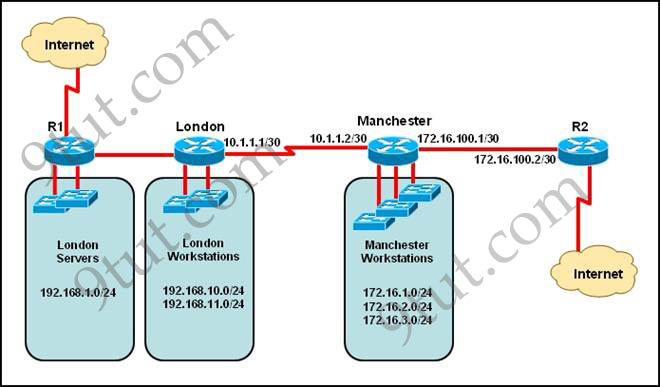
A. Configure a dynamic routing protocol on London to advertise all routes to Manchester.
B. Configure a dynamic routing protocol on London to advertise summarized routes to Manchester.
C. Configure a dynamic routing protocol on Manchester to advertise a default route to the London router.
D. Configure a static default route on London with a next hop of 10.1.1.1.
E. Configure a static route on London to direct all traffic destined for 172.16.0.0/22 to 10.1.1.2.
F. Configure Manchester to advertise a static default route to London.
Answer: E
Question 4
Which command is used to configure a default route?
A. ip route 172.16.1.0 255.255.255.0 0.0.0.0
B. ip route 172.16.1.0 255.255.255.0 172.16.2.1
C. ip route 0.0.0.0 255.255.255.0 172.16.2.1
D. ip route 0.0.0.0 0.0.0.0 172.16.2.1
Answer: D
Explanation
The simple syntax of static route:
ip route destination-network-address subnet-mask {next-hop-IP-address | exit-interface}
+ destination-network-address: destination network address of the remote network
+ subnet mask: subnet mask of the destination network
+ next-hop-IP-address: the IP address of the receiving interface on the next-hop router
+ exit-interface: the local interface of this router where the packets will go out
In the statement “ip route 0.0.0.0 0.0.0.0 172.16.2.1″:
+ 0.0.0.0 0.0.0.0: refer to any network
+ 172.16.2.1: the next-hop-IP-address
Question 5
If IP routing is enabled, which two commands set the gateway of last resort to the default gateway? (Choose two)
A. ip default-gateway 0.0.0.0
B. ip route 172.16.2.1 0.0.0.0 0.0.0.0
C. ip default-network 0.0.0.0
D. ip default-route 0.0.0.0 0.0.0.0 172.16.2.1
E. ip route 0.0.0.0 0.0.0.0 172.16.2.1
Answer: C E
Question 6
What must be set correctly when configuring a serial interface so that higher-level protocols calculate the best route?
A. bandwidth
B. delay
C. load
D. reliability
Answer: A
Explanation
Higher-level protocols (OSPF, EIGRP) calculate the best route mainly based on bandwidth so it must be set correctly -> A is correct.
Question 7
Which destination addresses will be used by Host A to send data to Host C? (Choose two)
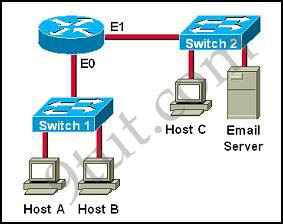
A. the IP address of Switch 1
B. the MAC address of Switch 1
C. the IP address of Host C
D. the MAC address of Host C
E. the IP address of the router’s E0 interface
F. the MAC address of the router’s E0 interface
Answer: C F
Explanation
While transferring data through many different networks, the source and destination IP addresses are not changed. Only the source and destination MAC addresses are changed. So in this case Host A will use the IP address of Host C and the MAC address of E0 interface to send data. When the router receives this data, it replaces the source MAC address with it own E1 interface’s MAC address and replaces the destination MAC address with Host C’s MAC address before sending to Host C -> C and F are correct.
Question 8
Which routing protocols can be used within the enterprise network shown in the diagram? (Choose three)

A. RIPv1
B. RIP v2
C. IGRP
D. OSPF
E. BGP
F. EIGRP
Answer: B D F
Explanation
RIPv1 & IGRP can not be used in this network because they do not support Variable Length Subnet Masking (VLSM) -> A and C are not correct.
BGP is a complicated routing protocol between different network (usually very big) or different Autonomous System. For example BGP can be used between two Internet Service Providers (ISP). The above network is very small in an enterprise so BGP is not a suitable choice -> E is not correct.
RIPv2 supports VLSM and can be used in networks which have less than 15 routers -> B is correct.
OSPF and EIGRP can be always used in most of enterprise networks -> D F are correct.
(But notice that EIGRP is a Cisco-proprietary routing protocol so it can be used in Cisco routers only)
Question 9
Which routing protocols will support the following IP addressing scheme? (Choose three)
Network 1 – 192.168.10.0 /26
Network 2 – 192.168.10.64 /27
Network 3 – 192.168.10.96 /27
Network 4 – 192.168.10.128 /30
Network 5 – 192.168.10.132 /30
A. RIP version 1
B. RIP version 2
C. IGRP
D. EIGRP
E. OSPF
Answer: B D E
Explanation
RIPv2, OSPF and EIGRP are classless routing protocol which support VLSM.
Question 10
Refer to the graphic. A static route to the 10.5.6.0/24 network is to be configured on the HFD router. Which commands will accomplish this? (Choose two)
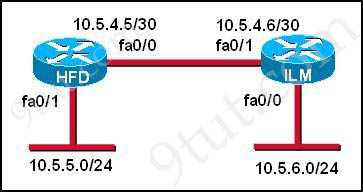
A. HFD (config) #ip route 10.5.6.0 0.0.0.255 fa0/0
B. HFD(config)# ip route 10.5.6.0 0.0.0.255 10.5.4.6
C. HFD(config)# ip route 10.5.6.0 255.255.255.0 fa0/0
D. HFD(config)# ip route 10.5.6.0 255.255.255.0 10.5.4.6
E. HFD(config)# ip route 10.5.4.6 0.0.0.255 10.5.6.0
F. HFD(config)# ip route 10.5.4.6 255.255.255.0 10.5.6.0
Answer: C D
Explanation
The simple syntax of static route:
ip route destination-network-address subnet-mask {next-hop-IP-address | exit-interface}
+ destination-network-address: destination network address of the remote network
+ subnet mask: subnet mask of the destination network
+ next-hop-IP-address: the IP address of the receiving interface on the next-hop router
+ exit-interface: the local interface of this router where the packets will go out
In the statement “ip route 10.5.6.0 255.255.255.0 fa0/0″:
+ 10.5.6.0 255.255.255.0: the destination network
+fa0/0: the exit-interface



So every week, is there a new dump.?
This is really helpful. Thanks 9tut :D
thank u for 9tut it is the best ever website for ccna thank u very much.::::::d
hw come class A subnet is 255.255.255.0
in question 10
@ jay VLSm my brother b it all in subnetting
thanks a lot 9tut……………..
i have a question that in real CCNA exam will all the questions come from this site ?..can anyone tell me
Hi, I have a doubt about question 1:
if the OSPF calculates the cost based on the formula : (100/Bandwidth)
then how did it choose the path R1 -> R3 -> R4 -> R5, ?
But based on the formula:
R1->R5 cost is only 64 K,
while R1 -> R3 -> R4 -> R5 cost is 2 Mbps
and R1->R2->R5 cost is around 32 Mbps
Can u explain how best path is chosen by ospf..? Plz
How dose a DHCP server dynamically assign IP address to host?
A. Addresses are allocated after a negotiation between the server and the host to determine the length of the agreement.
B. Addresses are assigned for a fixed period of time. At the end of period, a new quest for an address must be made, and another address is then assigned.
C. Addresses are leased to host. A host will usually keep the same address by periodically contacting the DHCP sever to renew the lease.
D. Addresses are permanently assigned so that the host uses the same address at all times.
please explain C. thanks guys.
@malik
OSPF:
Metric is cost, based on interface bandwidth by default
Link-state routing protocol.
they uses the interface with the highest bandwidth .
+ T1: 1.544 Mbps
+ T3: 45 Mbps (each T3 line consists of 28 T1 lines)
+ 10BaseT: 10 Mbps
+ 100BaseT (often referred to as FastEthernet): 100Mbps
Hello. Explain, please, why it should be A D E correct answers in Question 2.
I think correct answers are A C E.
Why in explanation author said “delay may be ignored” ? Every hop (router) increases delay so JAX-ORL way has less metric then two another equal ways.
What do you think about it, friends? If I’m not right, would you might explaining me this question more widly, please ?
To confirm it (see higher) I have created the same topology in PacketTracer with EIGRP routing between serial T1 links and 2 loopback interfaces on JAX and ORL routers.
After “show ip route” command on JAX router was executed, I saw that there was only 1 route to ORL loopback network through ORL-JAX serial link…
@BuSyTeR
I’m disagree with you mate. Let’s make it simple.
T1=1.544 Mbps speed and 2000 delay
T3=45 Mbps speed not sure about delay, but Deffinetly twice less that T1.
DID IT!!…907…thx 9tut!!!!..CCNA certified….tons of questions from this site…read from top to bottom every question, because you will not know what pops up….q3, 4, 7 on exam..
@BuSyTeR, @Mike is right.
EIGRP will use the link with the highest bandwidth and lowest delay. The T1 link right through the middle is worse than traversing the T3 links and extra router even though it may seem that T1 is more “direct”. And think about it… the T3 links can handle many times the traffic than T1 links, so you’ll want your traffic going through it as to avoid any congestion issues.
RIP will prefer the route with leasts hops, in RIPs opinion JAX-ORL is the best route.
Pls, can somebody send me the latest dumps, i have exam this month,
my email is asholet98@hotmail.com
Thanks
Can anyone send me latest CCNA dumps 640-802 to: CCNAdumpHELP2012@yahoo.com
hello@almira
here in your question regarding dhcp server confusion can be between two choices B and C.
but you can differentiate by taking simple example. when dhcp is configured there is option to set time limit for a ip assigned to a host. suppose that timing is small amount and after that time server will automatically deassign ip allocated to your host without asking for renewal it will be very boring task to ask for ip to dhcp again and again while you are doing some important work. so according to option C either server will ask for renewal or host will request for renewal of currently using ip.
i hope i am right. if wrong let me know
explanation to one is not satisfactory
say we know the ” speed” or bandwidth of each link then each link has a corresponding cost calculation: (formular 10^6/bandwidth)
fast Ether ———- 1
ethernet————10
T1——————-64
from this you get the answer( a) for the question for it add up of path cost is lowest
the other answer is correct thanks
Can anyone explain me how a DHCP server can automatically assigns a ip to hosts
Q-10 has a problem….. option A and option C have same meaning… similarly opt B and opt D are same…… only a wild card mask is used in A and C…dats the only difference…….
can someone send me the latest dumps I will be taking the test in the next few weeks? My email is wayne.goeden@gmail.com
plz I want visual certexam suite 3.0 1 registration code
so I can open “Cisco.ActualTests.640-802.v2012-07-15.by.Sekhar.697q.vce”
helpppppp meeeeee :)
Refer to the exhibit. According to the routing table, where will the router send a packet destined for 10.1.5.65?
Network Interface Next Hop
10.1.1.0/24 e0 DC
10.1.2.0 /24 e1 DC
10.1.3.0 /25 s0 DC
10.1.4.0 /24 s1 DC
10.1.5.0 /24 e0 10.1.1.2
10.1.5.64 /28 e1 10.1.2.2.
10.1.5.64 /29 s0 10.1.3.3
10.1.5.64 /27 s1 10.1.4.4
10.1.3.0
Can Anyone Explain ….what should be the ans
thank you for 9tut it is the best ever website for CCNA thank u very much.
hi,any latest dumps
hani_2012_rad@yahoo.com
@ Malik,
OSPF uses bandwidth to calculate the best path, not cost. Remember, its metrics is solely BANDWIDTH. It will always take ‘speedest’ path to a remote network. Concentrate strictly on metrics.
By the way thanks to 9tut for the help. Hey guys let’s donate to 9tut, how ever much you can afford. he’s doing a great job!
@malik and @Ahmed
ospf calculate formula
cost=10^8/least bandwidth
Recently took the CCNA, question 5 was on the exam. I clearly got it wrong, but I did complain about the question because NO WHERE is 172.16.2.1 mentioned in the question……so i ruled it out. My mistake…i don’t think like Cisco!!! In regards to the true answer….9tut does have it right…….
TY 9tut.
Today I have passed the CCNA. (860/825)
50 questions 3 labs (VTP, EIGRP, ACL). 35 from 9tut.
Also thanks a lot Brar and Sekhar (still valid from examcollection)
Ty again 9tut
Passed today question 4 and 7 on my exam. thax 9tut
@9tut do you have a CCNP site just like this one. if so please help
@Pank.
Ans: 10.1.5.64 /29 s0 10.1.3.3
9tut is the best website
Hello All,
If you comment on a question, can you make the first line of your comment the question #? That will help everyone. For example, (if) Ihave a comment or question about question #5 above, I would start like this:
Question #5:
Can someone explain the line “ip default-network 0.0.0.0″ and why C is the correct answet?
If you want to answer me or leran more about my question, all you have to do is go to question #5 for more information and background about my question.
Question #5:
In “ip default-network 0.0.0.0″ what network is represented by 0.0.0.0? I understand the syntax and just need to know the network represented by “0.0.0.0″
For example, the command “ip default-network 192.168.10.0″ will use the network address “192.168.10.0″ as gateway of last resort. In a topology with 20 networks, which one will be represented by “0.0.0.0″? I tend to believe that the nework address 0.0.0.0 is the same as “any (classful) network”, in which case the command “ip default-network 0.0.0.0″ would mean “send packets detsined to any (unknown) network” to “any network”.
My question is this: What (classful) network is represented by 0.0.0.0? Is it “any network”? If it is, how doess the router decide which network to send the packets to?
In other words, which network is the “any” network? “Any network” as “source” is easy to identify because it means I don’t care where you come from. However, “any network” as “destination” is complicated for obvious reason and that’s why it’s hard for me to believe that the “0.0.0.0″ network can mean “any destination network”.
please people I am asking for latest dumps please,my email is renojefa@gmail.com
I will realy apreciate your cooperation
Question #5:
In “ip default-network 0.0.0.0″ what network is represented by 0.0.0.0? I understand the syntax and just need to know the network represented by “0.0.0.0″
For example, the command “ip default-network 192.168.10.0″ will use the network address “192.168.10.0″ as gateway of last resort. In a topology with 20 networks, which one will be represented by “0.0.0.0″? I tend to believe that the nework address 0.0.0.0 is the same as “any (classful) network”, in which case the command “ip default-network 0.0.0.0″ would mean “send packets detsined to any (unknown) network” to “any network”.
My question is this: What (classful) network is represented by 0.0.0.0? Is it “any network”? If it is, how doess the router decide which network to send the packets to?
In other words, which network is the “any” network? “Any network” as “source” is easy to identify because it means I don’t care where you come from. However, “any network” as “destination” is complicated for obvious reason and that’s why it’s hard for me to believe that the “0.0.0.0″ network can mean “any destination network”.
Valid Que :D
Q:4
Q:7
In question 10, shouldn’t the exit interface be fa0/1?
1. Discuss the IP routing process involving two hosts (computers) and 1 router.
Plz tell me
At which layer of the OSI model does IPsec operate?
A. network
B. transport
C. session
D. application
@Usman
B. Network
http://www.tcpipguide.com/free/t_OSIReferenceModelLayerSummary.htm
This is for those who needs latest dumps. This dumps and 9tut, its enough for you to pass exam. just remember me in your prayers. Best of luck…..
http://www.examcollection.com/cisco/Cisco.ActualTests.640-802.v2012-07-15.by.Sekhar.697q.vce.file.html
@Arshad
answer is “Network”…. keep in mind any thing related with “IP” mostly or you can say always belong to layer 3”Network Layer” coz IP work on layer 3 “Routers”
Plz Correct me if I am wrong
Passed CCNA, question 5 from here.
Hello Guys I hope you will be fine there. I have CCNA (640-802) Vouchers on
special discount of 58% for World wide, with six months expiry date till you
purchase. Each voucher cost 60USD.
Details Required For CCNA Voucher For Discount Processing:
1-Full Name. 1st Name & Last Name (as you want to appear on certificate & documents)
2-Country.
3-City.
4-State.
5-Pin Code (or Area Code)
6-Residential Address (or where you can collect your Certificate or further correspondence
can be received)
Add me on Skype through this information which is written below:
Skype Name: rockon660
you can also email me at this email address which is written below:
madeelqaiser@gmail.com
If you have any Questions feel free to contact me.
Thanks,
Best regards,
Adeel
NO se necesita la conversion se deberia utilizar lo ya convertido :
Para los costos de enlace:
En cada enlace poner sus valores .
T1:64
T3:2
FastEhernet:F0/0 : 1
Ethernet e0/0 :10
56Kbps:1785
E1:48
Refer to the exhibit. According to the routing table, where will the router send a packet destined for 10.1.5.65?
Network Interface Next Hop
10.1.1.0/24 e0 DC
10.1.2.0 /24 e1 DC
10.1.3.0 /25 s0 DC
10.1.4.0 /24 s1 DC
10.1.5.0 /24 e0 10.1.1.2
10.1.5.64 /28 e1 10.1.2.2.
10.1.5.64 /29 s0 10.1.3.3
10.1.5.64 /27 s1 10.1.4.4
10.1.3.0
Q3 and Q7 were on today’s exam, Q3 used same topology but asked abou a default route from manchester to the internet.